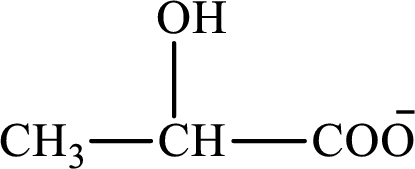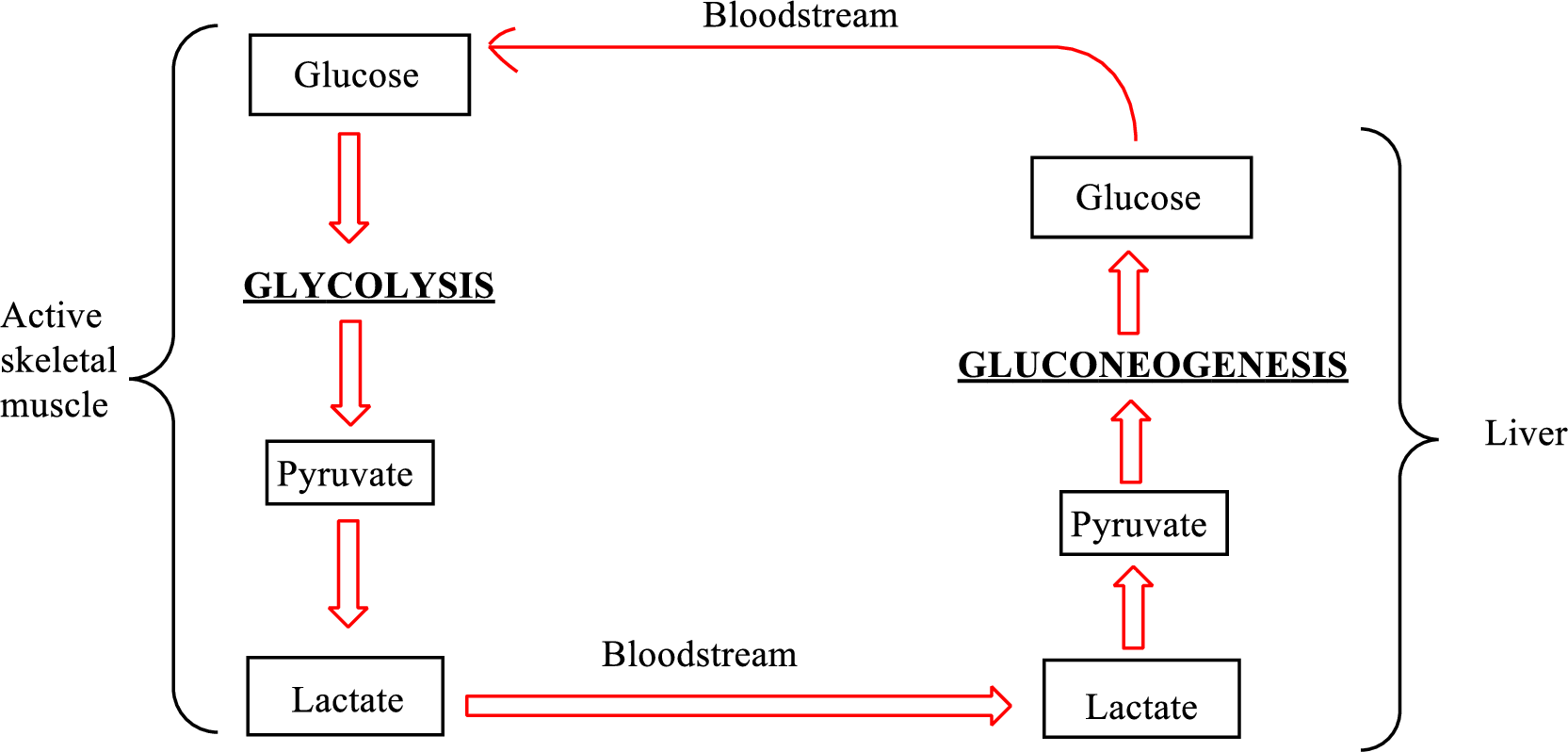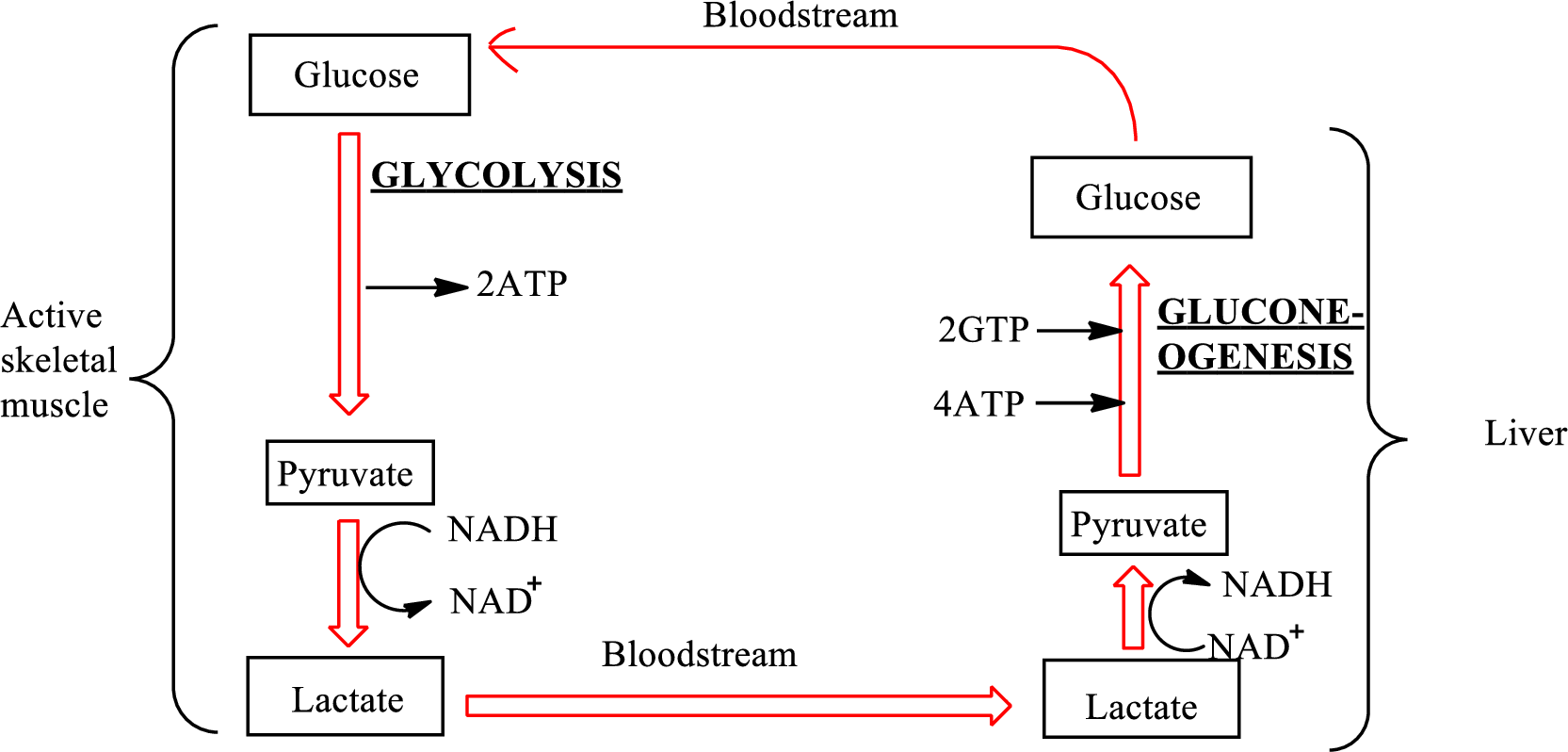
Concept explainers
(a)
Interpretation: To indicate whether lactate is involved in (1) the pentose phosphate pathway, (2) the Cori cycle, (3) glycolysis, or (4) lactate fermentation.
Concept introduction: The pentose phosphate pathway is defined as the metabolic pathway in which NADPH,
Glucose is converted to pyruvate by glycolysis metabolic pathway; pyruvate is further converted to lactate in the skeletal muscle cells by anaerobic reactions. The lactate is diffused into the bloodstream, by which it is transported to the liver. Lactate is reconverted to pyruvate. Gluconeogenesis metabolic pathway uses this pyruvate to synthesize glucose in the liver cells. Glucose is diffused into the bloodstream and is transported back to the active skeletal muscle cells. This cycle is known as the Cori cycle.
Glycolysis is the metabolic pathway that breaks down a glucose molecule and converts it into two pyruvate molecules along with the production of two ATP molecules and NADH coenzymes.
Fermentation is defined as the biochemical anaerobic process by which NADH is oxidized to
The structure of lactate is as follows:

(a)
Answer to Problem 13.105EP
Lactate is associated with (2) the Cori cycle and (4) the lactate fermentation.
Explanation of Solution
An overview of the Cori cycle is as follows:

Lactate is converted to pyruvate in the liver. Therefore, lactate is associated with the Cori cycle.
Pyruvate is converted to lactate under oxygen-poor conditions by lactate dehydrogenase enzymes in the human body. This anaerobic reduction of pyruvate to form lactate by enzymes is called lactate fermentation. The
Therefore, lactate is associated with the Cori cycle and the lactate fermentation.
(b)
Interpretation: To indicate whether
Concept introduction: The pentose phosphate pathway is defined as the metabolic pathway in which NADPH,
Glucose is converted to pyruvate by glycolysis metabolic pathway; pyruvate is further converted to lactate in the skeletal muscle cells by anaerobic reactions. The lactate is diffused into the bloodstream, by which it is transported to the liver. Lactate is reconverted to pyruvate. Gluconeogenesis metabolic pathway uses this pyruvate to synthesize glucose in the liver cells. Glucose is diffused into the bloodstream and is transported back to the active skeletal muscle cells. This cycle is known as the Cori cycle.
Glycolysis is the metabolic pathway that breaks down a glucose molecule and converts it into two pyruvate molecules along with the production of two ATP molecules and NADH coenzymes.
Pyruvate is converted to lactate under oxygen-poor conditions by lactate dehydrogenase enzymes in the human body. This anaerobic reduction of pyruvate to form lactate by enzymes is called lactate fermentation.
Nicotinamide adenine dinucleotide is associated with the
(b)
Answer to Problem 13.105EP
Explanation of Solution
An overview of the Cori cycle is as follows:

In the Cori cycle,
Pyruvate is converted to lactate under oxygen-poor conditions by lactate dehydrogenase enzymes in the human body. This anaerobic reduction of pyruvate to form lactate by enzymes is called lactate fermentation. The chemical reaction for the formation of lactate is as follows:
In the lactate fermentation, NADH is oxidized to
The net overall equation for the glycolysis process is as follows:
(c)
Interpretation: To indicate whether
Concept introduction: The pentose phosphate pathway is defined as the metabolic pathway in which NADPH,
Glucose is converted to pyruvate by glycolysis metabolic pathway; pyruvate is further converted to lactate in the skeletal muscle cells by anaerobic reactions. The lactate is diffused into the bloodstream, by which it is transported to the liver. Lactate is reconverted to pyruvate. Gluconeogenesis metabolic pathway uses this pyruvate to synthesize glucose in the liver cells. Glucose is diffused into the bloodstream and is transported back to the active skeletal muscle cells. This cycle is known as the Cori cycle.
Glycolysis is the metabolic pathway that breaks down a glucose molecule and converts it into two pyruvate molecules along with the production of two ATP molecules and NADH coenzymes.
Pyruvate is converted to lactate under oxygen-poor conditions by lactate dehydrogenase enzymes in the human body. This anaerobic reduction of pyruvate to form lactate by enzymes is called lactate fermentation.
(c)
Answer to Problem 13.105EP
Explanation of Solution
The first stage of the pentose phosphate pathway is the oxidative stage. In the oxidative stage (involves three steps) of the pentose phosphate pathway,
The general equation for the entire pentose phosphate pathway is as follows:
Therefore,
The net overall equation for the glycolysis process is as follows:
Glucose enters the glycolysis metabolic pathway in the form of
(d)
Interpretation: To indicate whether
Concept introduction: The pentose phosphate pathway is defined as the metabolic pathway in which NADPH,
Glucose is converted to pyruvate by glycolysis metabolic pathway; pyruvate is further converted to lactate in the skeletal muscle cells by anaerobic reactions. The lactate is diffused into the bloodstream, by which it is transported to the liver. Lactate is reconverted to pyruvate. Gluconeogenesis metabolic pathway uses this pyruvate to synthesize glucose in the liver cells. Glucose is diffused into the bloodstream and is transported back to the active skeletal muscle cells. This cycle is known as the Cori cycle.
Glycolysis is the metabolic pathway that breaks down a glucose molecule and converts it into two pyruvate molecules along with the production of two ATP molecules and NADH coenzymes.
Pyruvate is converted to lactate under oxygen-poor conditions by lactate dehydrogenase enzymes in the human body. This anaerobic reduction of pyruvate to form lactate by enzymes is called lactate fermentation.
(d)
Answer to Problem 13.105EP
Explanation of Solution
The first stage of the pentose phosphate pathway is the oxidative stage. In the oxidative stage (involves three steps) of the pentose phosphate pathway,
The first step of the second stage i.e. the non-oxidative stage of the pentose phosphate pathway is the isomerization of
Want to see more full solutions like this?
Chapter 13 Solutions
EBK ORGANIC AND BIOLOGICAL CHEMISTRY
- Indicate the formula of the compound, that is the result of the N- alquilación (nucleofílic substitution), in which an additional lateral chain was formed (NH-CH2-COOMe). F3C. CF3 NH NH2 Br о OMe K2CO3, DABCO, DMFarrow_forwardSynthesis of 1-metilbenzotriazole from 1,2-diaminobenceno.arrow_forwardSynthesis of 1-metilbenzotriazole.arrow_forward
- Indicate the formula of the compound, that is the result of the N- alquilación (nucleofílic substitution), in which an additional lateral chain was formed (NH-CH2-COOMe). F3C. CF3 NH NH2 Br о OMe K2CO3, DABCO, DMFarrow_forwardIdentify the mechanism through which the following reaction will proceed and draw the major product. Part 1 of 2 Br KOH EtOH Through which mechanism will the reaction proceed? Select the single best answer. E1 E2 neither Part: 1/2 Part 2 of 2 Draw the major product formed as a result of the reaction. Click and drag to start drawing a structure. Xarrow_forwardWhat is single-point calibration? Provide an example.arrow_forward
- Draw the major product formed via an E1 pathway.arrow_forwardPart 9 of 9 Consider the products for the reaction. Identify the major and minor products. HO Cl The E stereoisomer is the major product and the Z stereoisomer is the minor product ▼ S major product minor productarrow_forwardConsider the reactants below. Answer the following questions about the reaction mechanism and products. HO Clarrow_forward
- julietteyep@gmail.com X YSCU Grades for Juliette L Turner: Orc X 199 A ALEKS - Juliette Turner - Modul X A ALEKS - Juliette Turner - Modul x G butane newman projection - Gox + www-awa.aleks.com/alekscgi/x/Isl.exe/10_u-IgNslkr7j8P3jH-IBxzaplnN4HsoQggFsejpgqKoyrQrB2dKVAN-BcZvcye0LYa6eXZ8d4vVr8Nc1GZqko5mtw-d1MkNcNzzwZsLf2Tu9_V817y?10Bw7QYjlb il Scribbr citation APA SCU email Student Portal | Main Ryker-Learning WCU-PHARM D MySCU YSCU Canvas- SCU Module 4: Homework (Ch 9-10) Question 28 of 30 (1 point) | Question Attempt: 1 of Unlimited H₂SO heat OH The mechanism of this reaction involves two carbocation intermediates, A and B. Part 1 of 2 KHSO 4 rearrangement A heat B H₂O 2 OH Draw the structure of A. Check Search #t m Save For Later Juliet Submit Assignm 2025 McGraw Hill LLC. All Rights Reserved. Terms of Use | Privacy Center | Accessarrow_forwardThe electrons flow from the electron-rich atoms of the nucleophile to the electrons poor atoms of the alkyl halide. Identify the electron rich in the nucleophile. Enter the element symbol only, do not include any changes.arrow_forwardHello, I am doing a court case analysis in my Analytical Chemistry course. The case is about a dog napping and my role is prosecution of the defendant. I am tasked in the Area of Expertise in Neutron Activation and Isotopic Analysis. Attached is the following case study reading of my area of expertise! The landscaping stone was not particularly distinctive in its decoration but matched both the color and pattern of the Fluential’s landscaping stone as well as the stone in the back of the recovered vehicle. Further analysis of the stone was done using a technique called instrumental neutron activation analysis. (Proceed to Neutron Activation data) Photo Notes: Landscaping stone recovered in vehicle. Stone at Fluential’s home is similar inappearance. Finally, the white paint on the brick was analyzed using stable isotope analysis. The brick recovered at the scene had smeared white paint on it. A couple of pieces of brick in the back of the car had white paint on them. They…arrow_forward
 Chemistry for Today: General, Organic, and Bioche...ChemistryISBN:9781305960060Author:Spencer L. Seager, Michael R. Slabaugh, Maren S. HansenPublisher:Cengage Learning
Chemistry for Today: General, Organic, and Bioche...ChemistryISBN:9781305960060Author:Spencer L. Seager, Michael R. Slabaugh, Maren S. HansenPublisher:Cengage Learning General, Organic, and Biological ChemistryChemistryISBN:9781285853918Author:H. Stephen StokerPublisher:Cengage Learning
General, Organic, and Biological ChemistryChemistryISBN:9781285853918Author:H. Stephen StokerPublisher:Cengage Learning Organic And Biological ChemistryChemistryISBN:9781305081079Author:STOKER, H. Stephen (howard Stephen)Publisher:Cengage Learning,
Organic And Biological ChemistryChemistryISBN:9781305081079Author:STOKER, H. Stephen (howard Stephen)Publisher:Cengage Learning, Chemistry In FocusChemistryISBN:9781305084476Author:Tro, Nivaldo J., Neu, Don.Publisher:Cengage LearningChemistry: Matter and ChangeChemistryISBN:9780078746376Author:Dinah Zike, Laurel Dingrando, Nicholas Hainen, Cheryl WistromPublisher:Glencoe/McGraw-Hill School Pub Co
Chemistry In FocusChemistryISBN:9781305084476Author:Tro, Nivaldo J., Neu, Don.Publisher:Cengage LearningChemistry: Matter and ChangeChemistryISBN:9780078746376Author:Dinah Zike, Laurel Dingrando, Nicholas Hainen, Cheryl WistromPublisher:Glencoe/McGraw-Hill School Pub Co Introduction to General, Organic and BiochemistryChemistryISBN:9781285869759Author:Frederick A. Bettelheim, William H. Brown, Mary K. Campbell, Shawn O. Farrell, Omar TorresPublisher:Cengage Learning
Introduction to General, Organic and BiochemistryChemistryISBN:9781285869759Author:Frederick A. Bettelheim, William H. Brown, Mary K. Campbell, Shawn O. Farrell, Omar TorresPublisher:Cengage Learning





